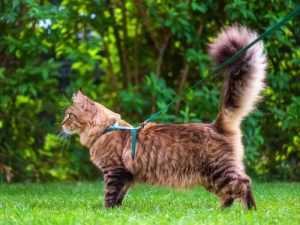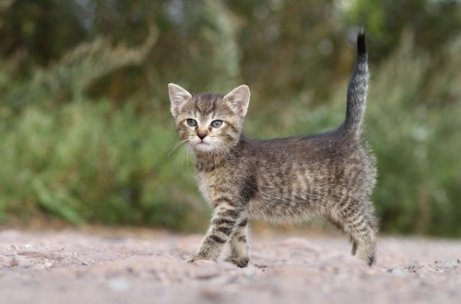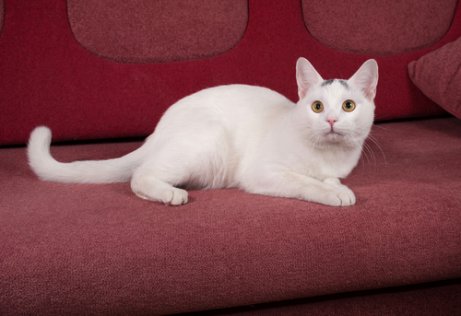The Language of a Cat's Tail: what they can tell us

Felines are animals that are very expressive with their bodies and the sounds they make. If you pay attention to the language of a cat’s tail, you’ll be able to see how the animal feels and act accordingly.
What does the language of a cat’s tail say?
A cat’s tails can be expressed through different shapes and sizes. In some cases, they are long, like in Siamese, or fluffy, like Angoras. Cats use their tails to demonstrate their moods and emotions. By paying attention to the language of a cat’s tail, you can identify what your pet wants to tell you just making certain movements.
1. Vertical tail
When your cat is walking through the house, garden, or yard and they have their tail in an upright position, but relaxed and pointing towards the sky — or ceiling — this means they feel safe and happy. If you see the tip of the tail bent, this is another sign they are enjoying themselves.

2. Tailed curved like a question mark
Sometimes you can notice — if you look closely — that cats curve half of their tail like a question mark. Do you know what that means? It means that your cat is inviting you to play with them for a while. So put aside what you’re doing and give them some attention. This position indicates they have a playful attitude, so He is looking to have some fun!
3. Tail waving up in the air
The language of a can’t tails can be difficult to interpret in some cases. For example, if your cats have their tail raised and are moving it back and forth, this could be taking place for two reasons. The first is that they’re in a good mood and are happy to see you.
However, the second reason is more “dangerous” because this is also the pose a cat takes before urinating on an object or place to make its territory.
4. Whipping it back and forth
You might be playing with your cat or petting them and, suddenly, you see that they start moving their tail from side to side. This indicates that they don’t want to play anymore. They could be getting uncomfortable or you are touching some of their “forbidden body part”… which could be more common than you think!
It’s likely that if you continue petting your cat when their tail starts moving their tail in this manner, they might choose to “hug” your hand or arm and bite you, first lightly and then again with more force. Therefore, if you see that they begin to move their tail like this, it would be a good idea to leave your cat alone.

5. Tail on the ground
When the animal is in an alert position with their tail resting on the ground and flicking its tip every so often, it means that the cat is irritated, indecisive, or thoughtful. When this movement is rather abrupt, this shows that they’re angry, may attack you or flee.
6. Rigid tail in a low position
Be very careful if your cat has a rigid tail in a low position. This is a clear sign of aggression. Your cat is in a really bad mood and you’d better not bothering them.
7. Coiled tail
Perhaps you’ve seen your cat sitting with their tail glued to their body while sleeping or lying in the sun. This means that your cat is very happy and relaxed!
8. Tail between the legs
This is a position of either submission or fear. A tail hidden between the legs can also mean there is something that is making your cat nervous.
9. Swinging tail
When a cat’s tail moves slightly to the side or to different positions, this means they are very concentrated on an object or something that has caught their attention. This could be anything from a toy, bird, insect or light coming in through a window.
Finally, if you cat coils its tail on another animal, for example, a dog, this is a way of showing affection. It’s a friendly feline-like hug. So, as you can see, understanding the language of a cat’s tail is important to establish a good bond.
Felines are animals that are very expressive with their bodies and the sounds they make. If you pay attention to the language of a cat’s tail, you’ll be able to see how the animal feels and act accordingly.
What does the language of a cat’s tail say?
A cat’s tails can be expressed through different shapes and sizes. In some cases, they are long, like in Siamese, or fluffy, like Angoras. Cats use their tails to demonstrate their moods and emotions. By paying attention to the language of a cat’s tail, you can identify what your pet wants to tell you just making certain movements.
1. Vertical tail
When your cat is walking through the house, garden, or yard and they have their tail in an upright position, but relaxed and pointing towards the sky — or ceiling — this means they feel safe and happy. If you see the tip of the tail bent, this is another sign they are enjoying themselves.

2. Tailed curved like a question mark
Sometimes you can notice — if you look closely — that cats curve half of their tail like a question mark. Do you know what that means? It means that your cat is inviting you to play with them for a while. So put aside what you’re doing and give them some attention. This position indicates they have a playful attitude, so He is looking to have some fun!
3. Tail waving up in the air
The language of a can’t tails can be difficult to interpret in some cases. For example, if your cats have their tail raised and are moving it back and forth, this could be taking place for two reasons. The first is that they’re in a good mood and are happy to see you.
However, the second reason is more “dangerous” because this is also the pose a cat takes before urinating on an object or place to make its territory.
4. Whipping it back and forth
You might be playing with your cat or petting them and, suddenly, you see that they start moving their tail from side to side. This indicates that they don’t want to play anymore. They could be getting uncomfortable or you are touching some of their “forbidden body part”… which could be more common than you think!
It’s likely that if you continue petting your cat when their tail starts moving their tail in this manner, they might choose to “hug” your hand or arm and bite you, first lightly and then again with more force. Therefore, if you see that they begin to move their tail like this, it would be a good idea to leave your cat alone.

5. Tail on the ground
When the animal is in an alert position with their tail resting on the ground and flicking its tip every so often, it means that the cat is irritated, indecisive, or thoughtful. When this movement is rather abrupt, this shows that they’re angry, may attack you or flee.
6. Rigid tail in a low position
Be very careful if your cat has a rigid tail in a low position. This is a clear sign of aggression. Your cat is in a really bad mood and you’d better not bothering them.
7. Coiled tail
Perhaps you’ve seen your cat sitting with their tail glued to their body while sleeping or lying in the sun. This means that your cat is very happy and relaxed!
8. Tail between the legs
This is a position of either submission or fear. A tail hidden between the legs can also mean there is something that is making your cat nervous.
9. Swinging tail
When a cat’s tail moves slightly to the side or to different positions, this means they are very concentrated on an object or something that has caught their attention. This could be anything from a toy, bird, insect or light coming in through a window.
Finally, if you cat coils its tail on another animal, for example, a dog, this is a way of showing affection. It’s a friendly feline-like hug. So, as you can see, understanding the language of a cat’s tail is important to establish a good bond.
This text is provided for informational purposes only and does not replace consultation with a professional. If in doubt, consult your specialist.








